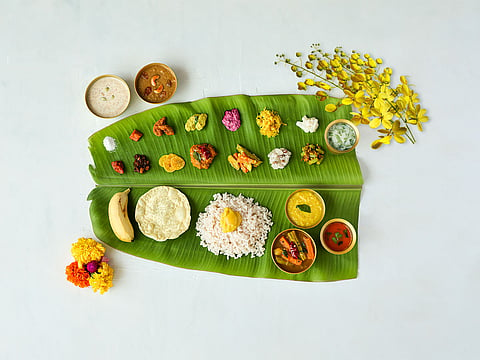Healthy Vishu Sadya made easy: Light, low-calorie and delicious dishes without the guilt
Try these low-calorie, guilt-free dishes and tips from dieticians for a festive feast

Did you say healthy Vishu?
Is there such a thing?
Oh, we hear the groans. But before the weight-watchers already tune out and write off Vishu celebrations this year, we’ve got some good news. You can still enjoy the grand, glorious Vishu Sadya and stick to your diet. And nope, we’re not talking about bland, sad alternatives. With just a couple of ingredient swaps, you can savour every bite of your Sadya – guilt-free.
Vishu, the vibrant festival that kicks off the Malayalam New Year, is famous for its feast that’s nothing short of a culinary celebration. From the warm, comforting Vishu kanji made with rice, coconut milk, and spices, to the rich, indulgent Vishu katta, crafted from freshly harvested rice powder, coconut milk, and jaggery – it’s a spread that tempts even the most disciplined. And then there’s the classic Veppampoorasam, that bold bitter neem concoction, or the Mampazhappulissery, a tangy mango soup that packs a zesty punch.
These dishes, made from freshly harvested ingredients, are packed with nutrients and energy. But here’s the catch: with all the ghee, dairy, coconut, sugar, and jaggery, plus those irresistible fried snacks, the calories can really add up.
But don’t worry, folks! You can still enjoy the magic of Vishu Sadya and keep your health goals on track. It’s all about finding the right balance – savoring the flavours without going overboard.
How, you ask?
Well, we’ve got expert advice from clinical dieticians Manjiri Nair and Sushma Ghag, Clinical Dietician, Aster Hospital Mankhool*) have a few smart suggestions to keep your Vishu feast both delicious and diet-friendl
Go for whole grains
Traditionally, rice plays a central role in the Sadya, but if you’re looking to make it healthier, swap it for brown rice, quinoa, or millets. These alternatives are rich in fibre, which helps you feel fuller for longer, and they have a lower glycemic index compared to white rice – making them a better choice for those managing their blood sugar levels.
The goodness of vegetables
The Vishu Sadya is rich in vegetable-based dishes, many of which are naturally low in calories and packed with essential nutrients. Dishes like avial, a mix of vegetables in a coconut-based gravy, and thoran, vegetable stir-fry with coconut, are both nutritious and light. To make them even healthier:
Use less coconut oil or opt for olive oil to sauté vegetables.
Limit the coconut milk in gravies, replacing it with a mix of low-fat yogurt or coconut water for a creamy texture without the extra calories.
Fill up on greens like spinach, drumsticks, and bitter gourd, which are great for digestion and packed with antioxidants.
Healthy protein choices
While dal (lentils) is often a staple in a Sadya, it's usually paired with ghee or coconut milk, adding extra fats. Instead:
Stick to plain cooked dal without the extra ghee. Add a dash of turmeric and black pepper for an anti-inflammatory boost.
Include tofu, chickpeas, or mung beans as plant-based protein options. These are lighter alternatives to the heavy meats and fish that are sometimes served with the Sadya.
Lighten up the Payasam
Ah that rich, sweetness. How can we do without it, this beautiful dish that has the highest calories?
Well, it's not too tough to swap the sweetness. Here’s how you can still enjoy the flavors you love.
Opt for a low-fat version by using almond milk or coconut milk instead of full-fat dairy.
Sweeten it with stevia or jaggery instead of refined sugar.
Consider using brown rice or millets instead of white rice for a healthier, whole-grain base.
Skip the fried items
Fried snacks like banana chips and upperi, fried coconut chips, are essential for a traditional Vishu Sadya, but are filled with unhealthy fats. Here’s what you can do:
Bake or air-fry the banana chips for a crispy snack without the added oils.
Instead of the greasy upperi, try making a coconut-flavoured roasted snack, using unsweetened dried coconut with a sprinkle of spices.
Keep cognisance of the portion control
The sheer variety of dishes can tempt you to pile your plate high, but portion control is key to enjoying a healthy Vishu Sadya. Here’s how you can balance your plate:
Fill half of your plate with vegetables – this will add fiber, vitamins, and minerals, while keeping your calorie intake in check.
Serve smaller portions of rich dishes like payasam, thoran, and sambhar to prevent overindulgence.
Drink plenty of water to help with digestion and avoid overeating.
Avoid sugary beverages
While sipping on sugary sweet drinks is a common part of the celebration, it’s better to steer clear of sugary lime juices and sherbets. Opt for:
Herbal teas like ginger tea or mint tea for digestion.
Coconut water for hydration and natural sweetness.
Other tips to keep in mind, advised by Ghag:
Start with portion controlled main courses and enjoy your desserts in moderation. Balance starchy and energy dense food groups such as rice, potato, yam, tapioca, banana- they come with more calories, so choose wisely and control portions.
• Fill up low calorie food such as non-starchy vegetables, stir fry vegetables, buttermilk, and clear soups.
• Minimise the intake of dishes made with coconut milk, oil-based pickles and fried papadum.
• Proteins from pulses are best absorbed when combined with rice as they form a complete protein by complementing amino acids. Dishes like Olan, Kottu curry, dal, sambar are good examples.
• Enjoy each dish in small quantity.
• Control your appetite and avoid overeating.
• Have a proper breakfast or a snack earlier in the day to prevent overeating during meals.
• Stay well hydrated throughout the day.
Sign up for the Daily Briefing
Get the latest news and updates straight to your inbox


